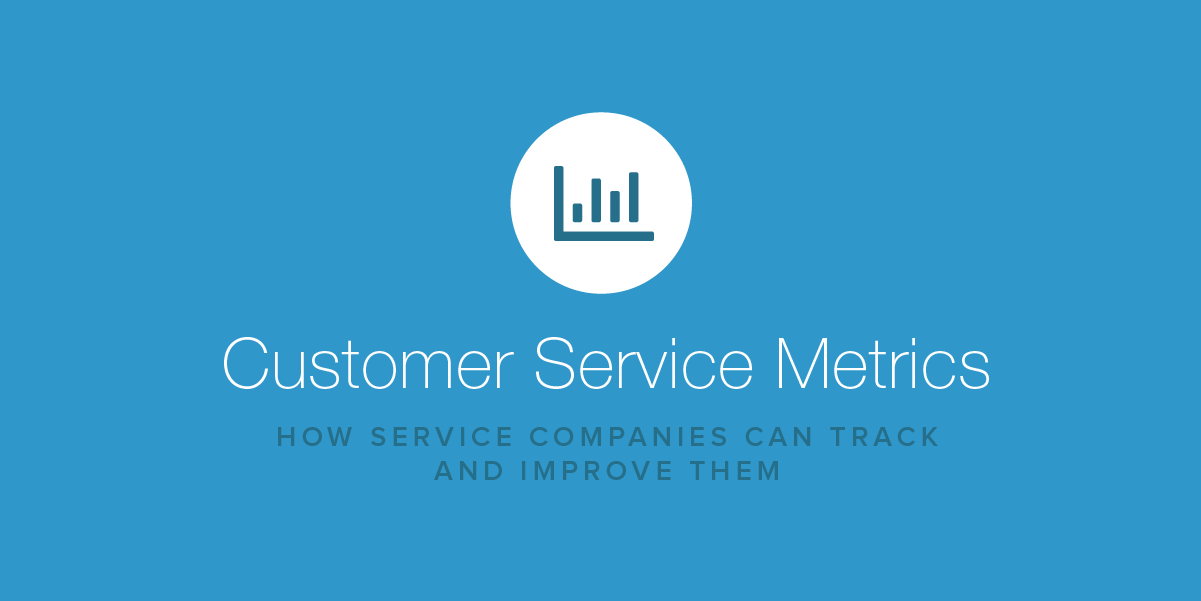How Service Businesses Can Track and Improve Customer Service Metrics
- October 14, 2018
- By: Vonigo
For service businesses, the quality of your customer service might be the most important part of your business. We live in a world of Yelp reviews and social media sharing, where word-of-mouth matters more than ever. It’s important to monitor your customer service metrics to keep your game strong.
Waiting to see how customers rate you on review sites is too passive. You should monitor your customer service metrics internally, too. That way you’ll know where you have to make improvements to keep the good reviews coming.
Here’s how to keep track of the stuff that matters, and make sure that you continue to score well.
Use Service Business Management Software
In order to measure your customer service metrics, you have to be tracking them. The easiest way to do that is to have a software system that logs all of your transactions. From the first time you hear from a customer, to how often they continue to book with you in the future, everything should be on the record.
You can try to keep track of these things with cobbled-together solutions, but that can be time-consuming and hard to maintain. A software solution designed specifically for service businesses is the best solution. That way, as you enter all of the information in the system, the software can generate reports for the metrics that matter most.

Identify your KPIs
When your goal is to maintain top-level customer service, the first thing you should do is set some goals. As we will expand on below, there are lots of different things you can track, but it’s easier to focus on just a few important ones.
Choose some KPIs (key performance indicators) that matter most to your company, and make them the focus of your efforts to improve. To keep it simple, consider starting with one top line goal and one bottom line goal. For example, if you are a moving company, you might want to focus on your conversion rate between leads or quotes and booked jobs, and the average dollar amount of each job.
KPI Examples
If you’re getting lots of leads and not converting enough of them to jobs on your calendar, that represents a huge opportunity. By simply improving your ability to close those sales, you can increase your revenue and profitability without any additional marketing or staff.
Within that one metric, there may be many changes you can make to improve. Your team can respond to leads faster. You can develop a set of exploratory and closing questions in a script that will help with sales. Or you can research your competition and find out why they are closing the leads that you aren’t. If your aim is to increase your job size, you can try to pursue the types of jobs that will accomplish that goal.
Track Your Performance Over Time
Improving your customer service metrics is not a task that can be done in a week or even a month. Always take a look at the long game, and watch your performance as it unfolds over time.
If you invest in the goal of improving your customer satisfaction over time, you will be able to identify trends and address them as they happen. Your KPIs might change from time to time in order to help you capitalize on your strengths or address your weaknesses. As the leader of a service business, the job of monitoring your customer service metrics never stops.
Put Systems in Place to Make Improvements
Once you have chosen your KPIs and set goals for each, it’s time to put a plan in place to improve them. As we mentioned above, once you have goals and key areas of focus, there is any number of things you can try to make improvements.
Keep a log of the things you’ve tested, and the results. Your service business management software will track things like how often a quote became a booked job. But it’s up to you to keep a record of when you introduced the new booking process, or tried a new script, or made an effort to decrease your response time.
When you try a new tactic to improve your customer service metrics and it works, make it part of your official policy. As you work through each metric in your business and make steady improvements, eventually your whole operation will be running more smoothly. Your reputation for great customer service should improve along with your internal metrics, too.

Get Buy-in from Your Whole Team
Monitoring and working to improve your customer service metrics should not be a solitary pursuit. Introduce your KPIs to your whole team, and revisit them often with the stakeholders responsible.
For example, you can have weekly meetings that discuss key numbers with your team, and have check-ins with the departments that are responsible for those metrics. Like monitoring closing ratios with your call center team. Or reviewing your customer satisfaction metrics with your field teams.
When the whole team knows about your goals and is working towards them, improvements will come easier. When you hit your targets or see promising improvements, celebrate those wins. Not only will it help your internal metrics, but it will improve job satisfaction among your team to know that their efforts make a difference.

Some Other Customer Service Metrics to Consider
If you want a single data point that you can use to measure the quality of your customer service, consider using an NPS score. Your NPS score is the likelihood out of 10 that your customer would recommend your service to others. To get this score, you ask your customers one question: How likely (out of 10) are they to recommend you?
As we’ve mentioned though, there are many more metrics that you can track within your service business management software. Here are a few that you can track and make improvements to.
Time-to-Booking
How long it takes to take a customer from the first contact to booking is a great value to keep track of. Though it is not a direct reflection of your customer service, the speed in which you engage customers can help you win bookings and improve your conversion rates as well.
Keep a running tally of how long it takes from when a customer first makes contact, to when they book a job on your calendar. The easiest way to have a big impact on this is by offering online booking. When a customer is free to book the job themselves at their leisure, they may choose to book immediately.
If your system involves offering a price quote before a booking happens, work to improve your response time or systems to get quotes out faster (or immediately). Often times, the vendor who responds the fastest will win the booking, so aim to be first to offer a quote as often as you can.
Average Dollar Sale/Service
What is the average value of each job you perform? There are some fixed “opportunity costs” for your business in order to book a job. To increase your profitability, doing the same amount of work to book a higher-priced job is a great way to grow.
How can you make changes to book higher priced jobs? You could expand your services, focus on cross-selling and upselling, target neighborhoods with larger homes, or even consider doing more commercial work. You certainly don’t have to change your pricing to increase your average dollar sale, but that’s another way to have an impact.
By simply focusing on pursuing higher-value jobs, you can boost your companies profitability while still remaining competitive with pricing.

Jobs per Day/Week/Month
How many jobs does each of your crews complete in a given time frame? Which teams are the most efficient? What are the factors that make some faster than others? Maybe it’s experience, or maybe it’s something even less obvious, like driving routes, traffic or even the quality of your equipment.
Monitor the performance of your fastest and slowest teams and look for ways to improve efficiency. You should also take into account how that efficiency affects other areas of the business too.
Encouraging your teams to work faster might have an adverse effect on your overall customer service, but there might be ways to do it that will improve morale too. Using Google Maps for driving instructions that monitor traffic flow, for example. Or replacing machinery that costs you in productivity. If an older carpet steamer is forcing one of your teams to take 50% longer to complete a job, that might be an investment worth making immediately.
Jobs per Technician
Who are your top performers? If you measure the number of jobs that each technician performs, you might identify some superstars within your ranks.
If one technician or team is outperforming the rest, find out what makes them more efficient. Are they doing a quality job, or working too quickly? Do they have more experience or efficiency shortcuts they can share with the rest of the team?
Depending on what you learn when you dig into these figures, you might identify team members who are qualified for promotions to management. After all, shouldn’t your best performers be mentoring the rest of the team?
% of Repeat Customers
Whether a customer returns is one of the most important customer service metrics you can measure. Even more important than your NPS score, the likelihood that customer will book again is paramount. If your business is the kind that deals with a lot of repeat customers, like cleaning businesses, for example, then it’s of the utmost importance.
Repeat customers are the most profitable for your business. For one thing, you don’t have to pay more (in advertising, sales calls, marketing) to reacquire them. And for another, as they grow familiar with your business, both you and the team will be more efficient at completing the service.
Lifetime Value of Customers
With repeat customers, they are worth a lot more to you than the cost of any one booking. How successful are you at maintaining your customers over the long term, and how much are they worth to you over the long haul?
Let’s say you’re deciding to invest in a form of advertising, like Google Adwords or Facebook. You will probably have a maximum amount that you’d like to spend to acquire a new customer. Not all customers are created equal though. If they commit to a monthly service, their “lifetime value” is worth a lot.
If you know how many customers book more than once, and how much the average customer is worth to you in lifetime value, the amount you’ll invest to acquire them changes drastically. For this reason, it’s important to keep track of your numbers and how they impact your growth.
Small Improvements Add Up
You don’t have to make drastic improvements instantly. A small improvement this week can add up over time. For example, a 1% improvement each week is a 50% improvement in a year and 100% in two years.
When you take a look at the long-term effects of your efforts to improve, you can achieve a sustainable amount of growth and improvement.
Expecting to reinvent the wheel overnight can be challenging and discouraging. Changing things incrementally and watching the effect take place over time can be encouraging. It can also have a positive impact on your bottom line.
Service Software that Tracks Customer Service Metrics
Software with online booking and scheduling make all of this kind of tracking and measurement possible. Generating reports weekly or monthly will give you a much better sense of your performance. And it doesn’t have to take a lot of effort to do. The software is designed to handle the reports for you.
Interested to learn more about how you can track and improve your team’s performance, using software that was built specifically for your type of company? Book a free, private demo of Vonigo.




